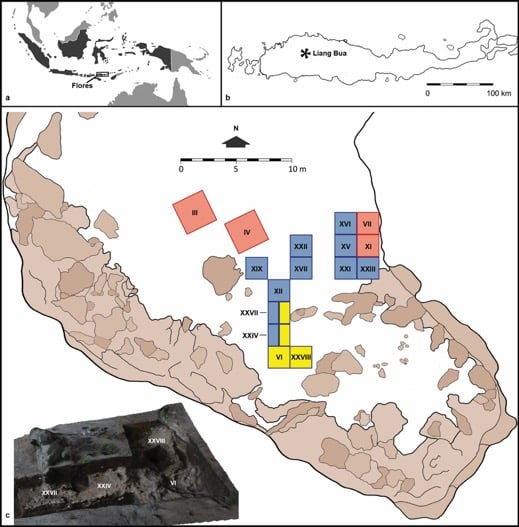Matt Tocheri is the Canada Research Chair in Human Origins at Lakehead University and a Research Associate in the Smithsonian Institution’s Human Origins Program. He was awarded a Leakey Foundation Research Grant during our fall 2016 cycle for his project entitled “New archaeological excavations at Liang Bua (Flores, Indonesia).”

Liang Bua, a large limestone cave on the Indonesian island of Flores, is an incredible site best known for the discovery in 2003 of the extinct human species Homo floresiensis. Tourists from Indonesia and around the world visit the site almost daily throughout the year on locally-guided tours. In this image, Matt Tocheri and Thomas Sutikna are sitting at the table discussing plans for their excavations in 2012. (Image Credit: Smithsonian Digitization Program Office and the Liang Bua Team)
In 2003 and 2004, archaeologists excavating on the Indonesian island of Flores uncovered a partial human skeleton roughly six meters beneath the present-day surface of a cave called Liang Bua. Their discovery would soon spark intense scientific debates worldwide and attract a level of public interest rarely seen in any scientific discipline. The recovered skull revealed an extremely small, chimpanzee-sized brain (~400 cm3) while the limb bones showed this fully-grown adult would have stood about 1 m tall and had australopith-like body proportions. The remarkable discovery, which made the cover of the journal Nature in October 2004, presented the world with a new member of the human family tree called Homo floresiensis, referred to informally as the “hobbits” of human evolution.
The implications were startling: human biological diversity during the terminal Pleistocene was significantly larger than what it is today. Until relatively recently our species shared this planet with Neandertals and Denisovans as well as this even more distantly related evolutionary cousin that also walked upright, and made and used stone tools. What exactly happened to this branch of our human family tree is still poorly understood, but current evidence shows that they disappear from the Liang Bua stratigraphic sequence around 60–50 thousand years ago.
We cannot physically travel back in time in order to save this lineage of our family tree from extinction, but we can strive to learn as much as possible about when and why they ultimately went extinct, and whether members of our own species, Homo sapiens, played any direct or indirect role in the process. Building knowledge and understanding about Homo floresiensis provides an important and unique perspective on the ramifications of losing diversity—be it biological, cultural, or linguistic—and helps society and individuals make better, more informed arguments for preserving diversity among all species that survive today.

The location of Flores within Indonesia (a), the location of Liang Bua on Flores (b), and the site plan of main areas excavated in previous years (2001–2004 in red and 2007–2014 in blue) with the targeted area for our current project, funded by The Leakey Foundation, shown in yellow (c) (modified from Sutikna et al., 2016 Nature). Roman numerals denote the Sector names designated by The National Research Centre for Archaeology in Indonesia. The remaining cave floor sediments are shaded white, while the areas shaded brown are exposed rocks, stalagmites and other surfaces covered in speleothems. The image inset at bottom left shows ~12 m2 of the exposed upper surface of the ~20–24 ka-old flowstone that caps the sediments targeted for excavation this year. Our research will begin by removing this flowstone and then continuing in 10-cm intervals while following the stratigraphic units as defined from our previous excavations in this area (see Morley et al., 2017 Journal of Archaeological Science). (Image Credit: the Liang Bua Team)
The stratigraphic sequence at Liang Bua does not end abruptly at 60–50 thousand years ago. A recently excavated 1 x 4 m test trench within the middle rear part of the cave led to the identification of deposits dated to between 46 and 24 thousand years ago that directly overly 60–50-thousand-year-old sediments. Our project, generously funded by The Leakey Foundation, will significantly extend these earlier excavations over a ~12 m2 area in this part of the cave. This offers an unprecedented opportunity to test whether Homo floresiensis and other associated endemic fauna (e.g., pygmy Stegodon) survived after ~50 thousand years ago. At the same time, our project has strong potential to reveal important new knowledge about the arrival, morphology, and behavior of the earliest modern human populations to reach Flores, as well as how this prehistoric dispersal may relate to the successful colonization of Island Southeast Asia and Australia ~50 thousand years ago by the ancestors of living Australomelanesian populations.

The Liang Bua Team in 2016. A majority of our team members are from the villages of Teras, Bere, and Golo Manuk that immediately surround Liang Bua. Many of our local team members have worked at the Liang Bua excavations since 2001 while some even worked for excavations conducted between 1978 and 1989. These local people are incredibly experienced and have considerable archaeological skills and knowledge. Our archaeological research at Liang Bua is a source of great pride among people living in this area and on Flores more broadly. Matt Tocheri is in the top row at far right and Thomas Sutikna (project co-PI), from the University of Wollongong, Australia, is at the far left of the second row from the top. (Image Credit: the Liang Bua Team)






Comments 0